Analyzing Employee Motivation Strategies for Enhanced Performance
VerifiedAdded on 2020/04/07
|9
|2326
|658
AI Summary
The paper underlines the critical message to emerging managers that utilizing diverse motivational tools can enhance worker efficiency and performance, leading to higher productivity. Different tools affect employees variably, necessitating a tailored approach by understanding employee categories. The significance of motivation is further supported by studies from Ackah (2015) demonstrating job satisfaction among motivated employees in Ghana's manufacturing sector, Deci & Ryan (2014) linking intrinsic work motivation with self-determination theory, and Osabiya (2015) noting the positive organizational outcomes like belonging and responsibility from motivation. Furthermore, Shahzadi et al. (2014) highlight a significant correlation between employee motivation and performance through regression analysis, while Njoroge & Yazdanifard (2014) discuss emotional intelligence's impact on motivation in diverse workplaces. In conclusion, managerial understanding of motivational theories is essential for job performance enhancement.
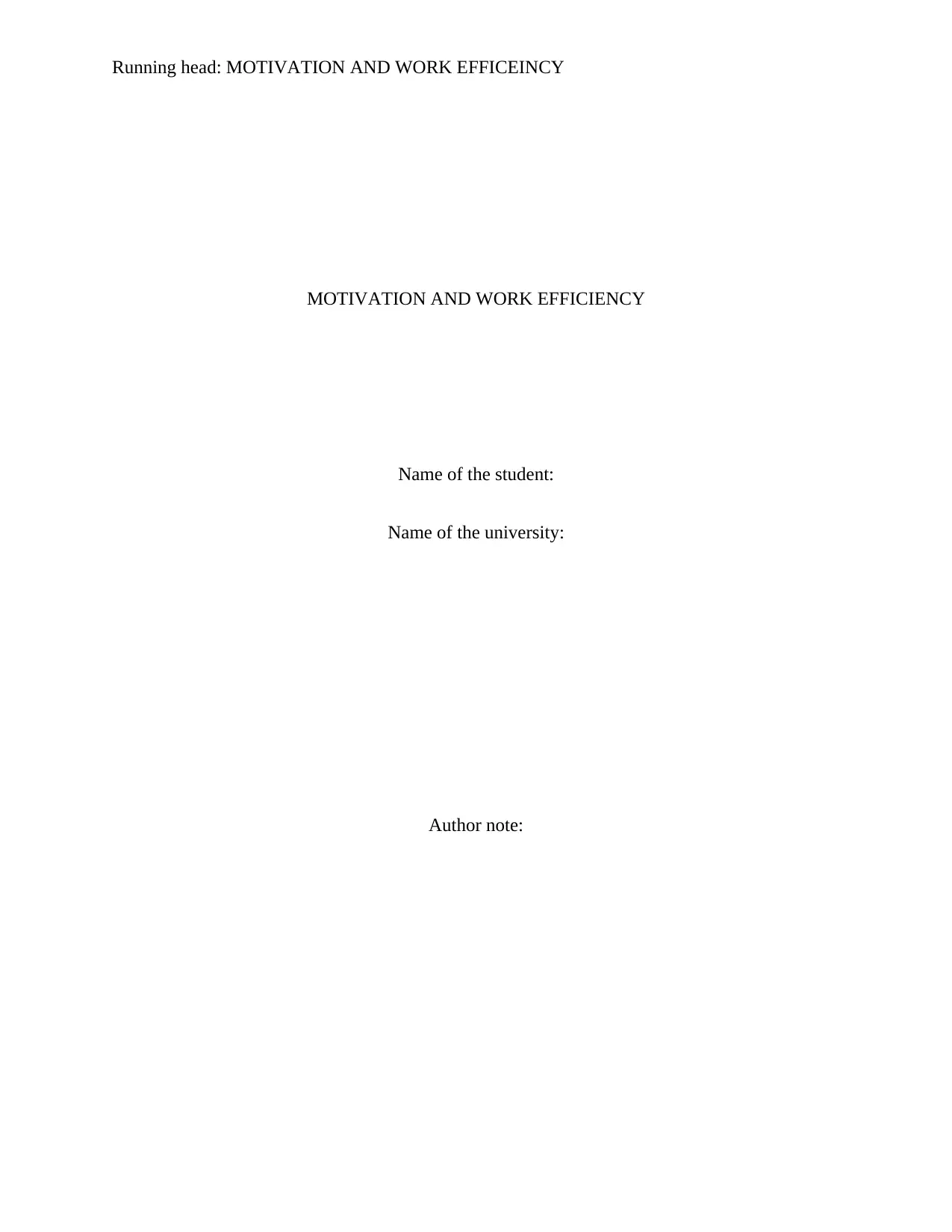
Running head: MOTIVATION AND WORK EFFICEINCY
MOTIVATION AND WORK EFFICIENCY
Name of the student:
Name of the university:
Author note:
MOTIVATION AND WORK EFFICIENCY
Name of the student:
Name of the university:
Author note:
Paraphrase This Document
Need a fresh take? Get an instant paraphrase of this document with our AI Paraphraser
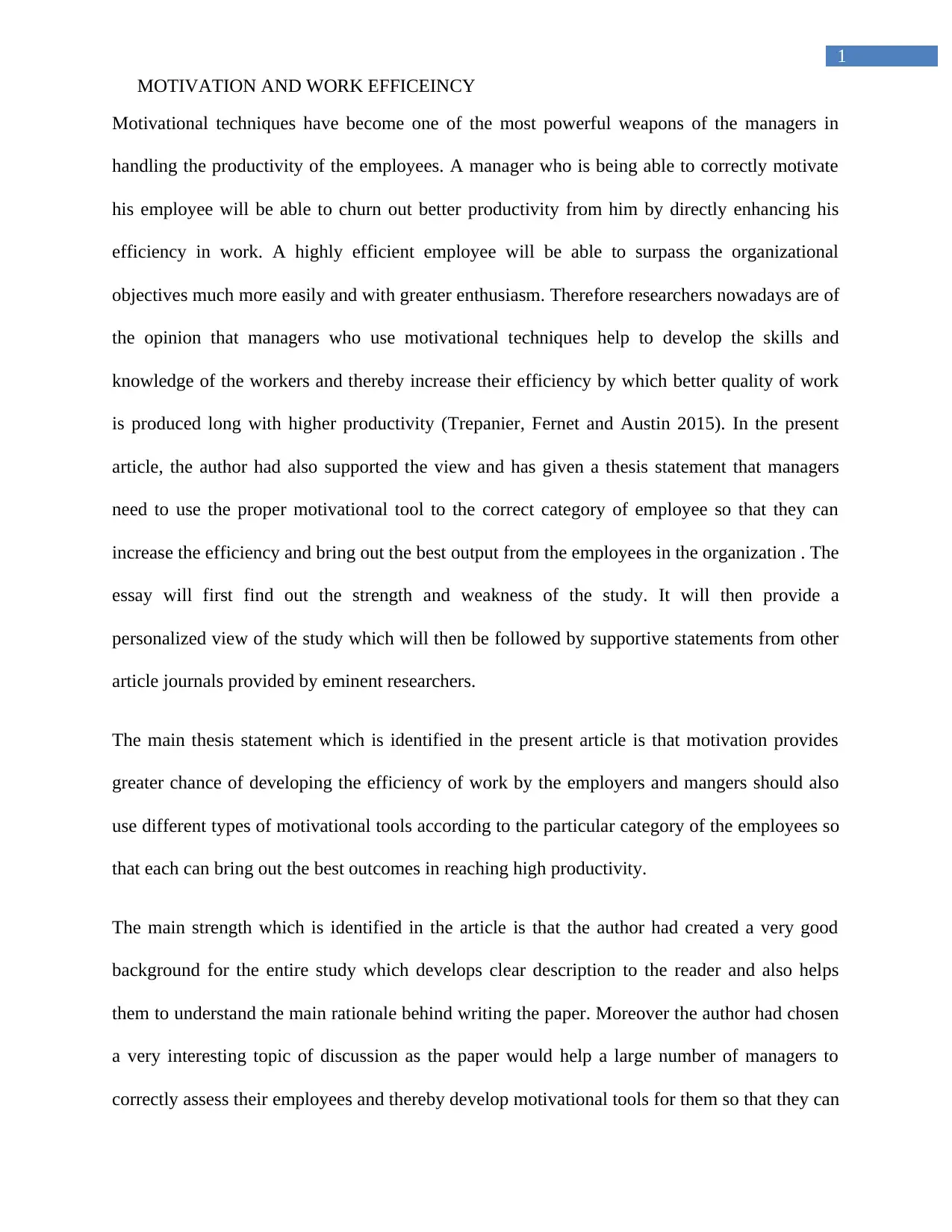
1
MOTIVATION AND WORK EFFICEINCY
Motivational techniques have become one of the most powerful weapons of the managers in
handling the productivity of the employees. A manager who is being able to correctly motivate
his employee will be able to churn out better productivity from him by directly enhancing his
efficiency in work. A highly efficient employee will be able to surpass the organizational
objectives much more easily and with greater enthusiasm. Therefore researchers nowadays are of
the opinion that managers who use motivational techniques help to develop the skills and
knowledge of the workers and thereby increase their efficiency by which better quality of work
is produced long with higher productivity (Trepanier, Fernet and Austin 2015). In the present
article, the author had also supported the view and has given a thesis statement that managers
need to use the proper motivational tool to the correct category of employee so that they can
increase the efficiency and bring out the best output from the employees in the organization . The
essay will first find out the strength and weakness of the study. It will then provide a
personalized view of the study which will then be followed by supportive statements from other
article journals provided by eminent researchers.
The main thesis statement which is identified in the present article is that motivation provides
greater chance of developing the efficiency of work by the employers and mangers should also
use different types of motivational tools according to the particular category of the employees so
that each can bring out the best outcomes in reaching high productivity.
The main strength which is identified in the article is that the author had created a very good
background for the entire study which develops clear description to the reader and also helps
them to understand the main rationale behind writing the paper. Moreover the author had chosen
a very interesting topic of discussion as the paper would help a large number of managers to
correctly assess their employees and thereby develop motivational tools for them so that they can
MOTIVATION AND WORK EFFICEINCY
Motivational techniques have become one of the most powerful weapons of the managers in
handling the productivity of the employees. A manager who is being able to correctly motivate
his employee will be able to churn out better productivity from him by directly enhancing his
efficiency in work. A highly efficient employee will be able to surpass the organizational
objectives much more easily and with greater enthusiasm. Therefore researchers nowadays are of
the opinion that managers who use motivational techniques help to develop the skills and
knowledge of the workers and thereby increase their efficiency by which better quality of work
is produced long with higher productivity (Trepanier, Fernet and Austin 2015). In the present
article, the author had also supported the view and has given a thesis statement that managers
need to use the proper motivational tool to the correct category of employee so that they can
increase the efficiency and bring out the best output from the employees in the organization . The
essay will first find out the strength and weakness of the study. It will then provide a
personalized view of the study which will then be followed by supportive statements from other
article journals provided by eminent researchers.
The main thesis statement which is identified in the present article is that motivation provides
greater chance of developing the efficiency of work by the employers and mangers should also
use different types of motivational tools according to the particular category of the employees so
that each can bring out the best outcomes in reaching high productivity.
The main strength which is identified in the article is that the author had created a very good
background for the entire study which develops clear description to the reader and also helps
them to understand the main rationale behind writing the paper. Moreover the author had chosen
a very interesting topic of discussion as the paper would help a large number of managers to
correctly assess their employees and thereby develop motivational tools for them so that they can
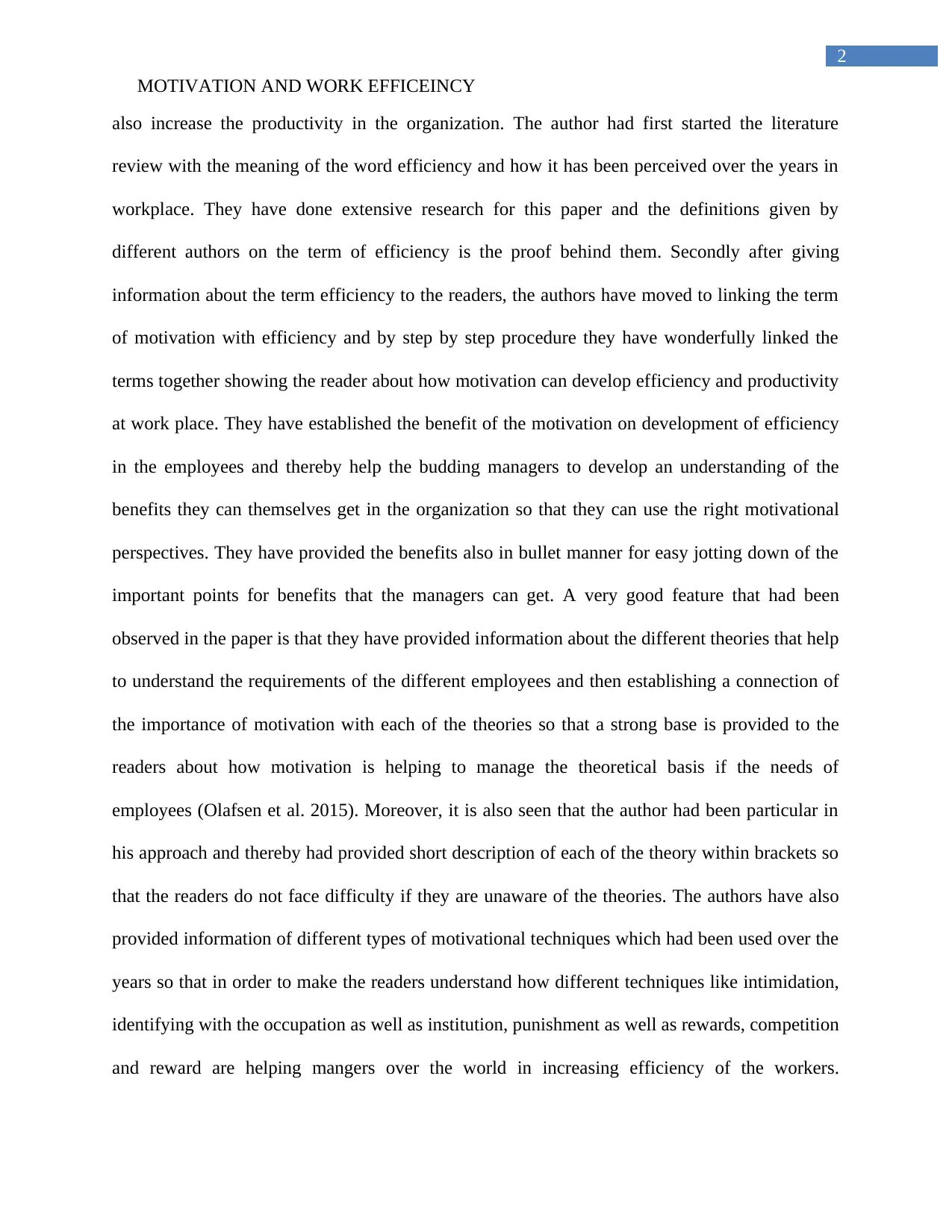
2
MOTIVATION AND WORK EFFICEINCY
also increase the productivity in the organization. The author had first started the literature
review with the meaning of the word efficiency and how it has been perceived over the years in
workplace. They have done extensive research for this paper and the definitions given by
different authors on the term of efficiency is the proof behind them. Secondly after giving
information about the term efficiency to the readers, the authors have moved to linking the term
of motivation with efficiency and by step by step procedure they have wonderfully linked the
terms together showing the reader about how motivation can develop efficiency and productivity
at work place. They have established the benefit of the motivation on development of efficiency
in the employees and thereby help the budding managers to develop an understanding of the
benefits they can themselves get in the organization so that they can use the right motivational
perspectives. They have provided the benefits also in bullet manner for easy jotting down of the
important points for benefits that the managers can get. A very good feature that had been
observed in the paper is that they have provided information about the different theories that help
to understand the requirements of the different employees and then establishing a connection of
the importance of motivation with each of the theories so that a strong base is provided to the
readers about how motivation is helping to manage the theoretical basis if the needs of
employees (Olafsen et al. 2015). Moreover, it is also seen that the author had been particular in
his approach and thereby had provided short description of each of the theory within brackets so
that the readers do not face difficulty if they are unaware of the theories. The authors have also
provided information of different types of motivational techniques which had been used over the
years so that in order to make the readers understand how different techniques like intimidation,
identifying with the occupation as well as institution, punishment as well as rewards, competition
and reward are helping mangers over the world in increasing efficiency of the workers.
MOTIVATION AND WORK EFFICEINCY
also increase the productivity in the organization. The author had first started the literature
review with the meaning of the word efficiency and how it has been perceived over the years in
workplace. They have done extensive research for this paper and the definitions given by
different authors on the term of efficiency is the proof behind them. Secondly after giving
information about the term efficiency to the readers, the authors have moved to linking the term
of motivation with efficiency and by step by step procedure they have wonderfully linked the
terms together showing the reader about how motivation can develop efficiency and productivity
at work place. They have established the benefit of the motivation on development of efficiency
in the employees and thereby help the budding managers to develop an understanding of the
benefits they can themselves get in the organization so that they can use the right motivational
perspectives. They have provided the benefits also in bullet manner for easy jotting down of the
important points for benefits that the managers can get. A very good feature that had been
observed in the paper is that they have provided information about the different theories that help
to understand the requirements of the different employees and then establishing a connection of
the importance of motivation with each of the theories so that a strong base is provided to the
readers about how motivation is helping to manage the theoretical basis if the needs of
employees (Olafsen et al. 2015). Moreover, it is also seen that the author had been particular in
his approach and thereby had provided short description of each of the theory within brackets so
that the readers do not face difficulty if they are unaware of the theories. The authors have also
provided information of different types of motivational techniques which had been used over the
years so that in order to make the readers understand how different techniques like intimidation,
identifying with the occupation as well as institution, punishment as well as rewards, competition
and reward are helping mangers over the world in increasing efficiency of the workers.
⊘ This is a preview!⊘
Do you want full access?
Subscribe today to unlock all pages.

Trusted by 1+ million students worldwide
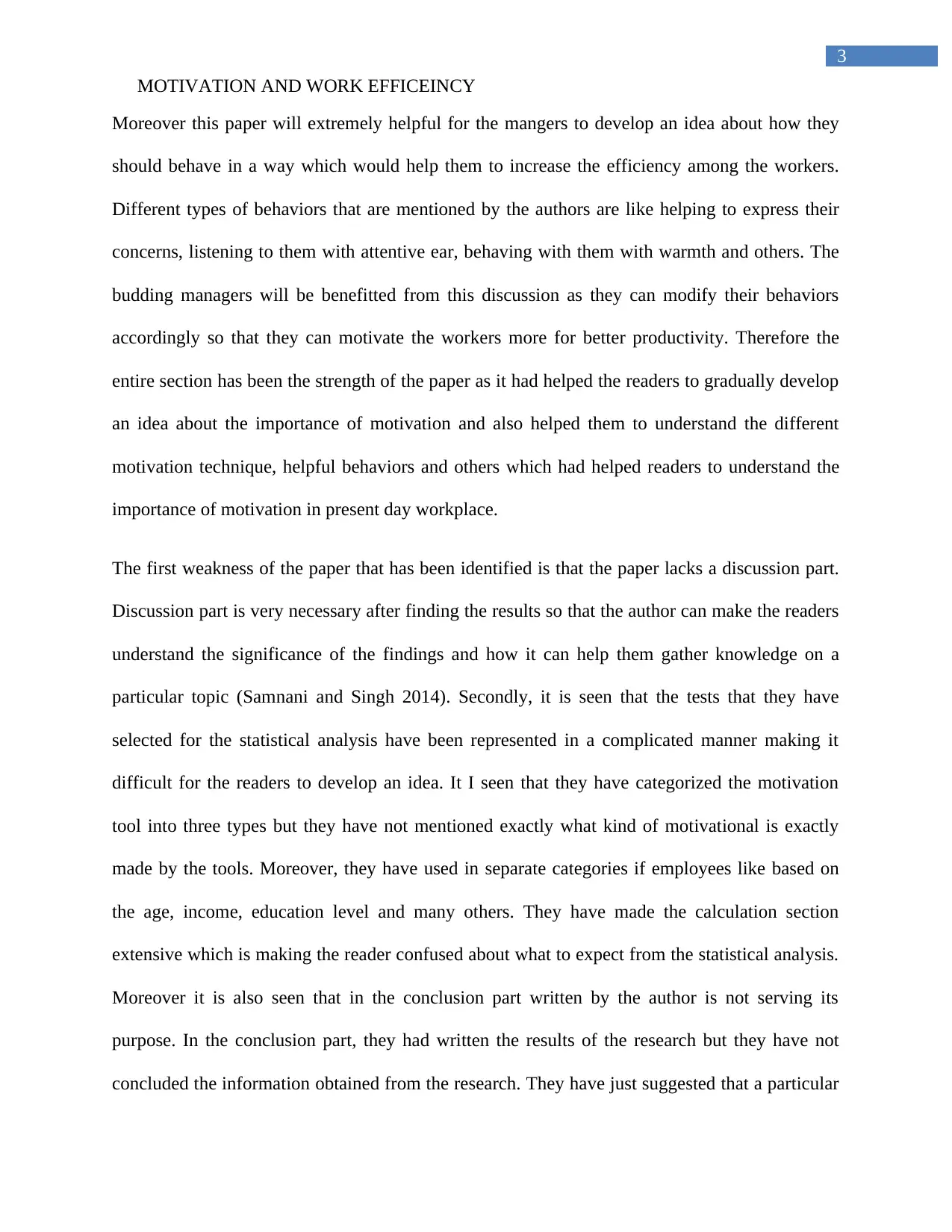
3
MOTIVATION AND WORK EFFICEINCY
Moreover this paper will extremely helpful for the mangers to develop an idea about how they
should behave in a way which would help them to increase the efficiency among the workers.
Different types of behaviors that are mentioned by the authors are like helping to express their
concerns, listening to them with attentive ear, behaving with them with warmth and others. The
budding managers will be benefitted from this discussion as they can modify their behaviors
accordingly so that they can motivate the workers more for better productivity. Therefore the
entire section has been the strength of the paper as it had helped the readers to gradually develop
an idea about the importance of motivation and also helped them to understand the different
motivation technique, helpful behaviors and others which had helped readers to understand the
importance of motivation in present day workplace.
The first weakness of the paper that has been identified is that the paper lacks a discussion part.
Discussion part is very necessary after finding the results so that the author can make the readers
understand the significance of the findings and how it can help them gather knowledge on a
particular topic (Samnani and Singh 2014). Secondly, it is seen that the tests that they have
selected for the statistical analysis have been represented in a complicated manner making it
difficult for the readers to develop an idea. It I seen that they have categorized the motivation
tool into three types but they have not mentioned exactly what kind of motivational is exactly
made by the tools. Moreover, they have used in separate categories if employees like based on
the age, income, education level and many others. They have made the calculation section
extensive which is making the reader confused about what to expect from the statistical analysis.
Moreover it is also seen that in the conclusion part written by the author is not serving its
purpose. In the conclusion part, they had written the results of the research but they have not
concluded the information obtained from the research. They have just suggested that a particular
MOTIVATION AND WORK EFFICEINCY
Moreover this paper will extremely helpful for the mangers to develop an idea about how they
should behave in a way which would help them to increase the efficiency among the workers.
Different types of behaviors that are mentioned by the authors are like helping to express their
concerns, listening to them with attentive ear, behaving with them with warmth and others. The
budding managers will be benefitted from this discussion as they can modify their behaviors
accordingly so that they can motivate the workers more for better productivity. Therefore the
entire section has been the strength of the paper as it had helped the readers to gradually develop
an idea about the importance of motivation and also helped them to understand the different
motivation technique, helpful behaviors and others which had helped readers to understand the
importance of motivation in present day workplace.
The first weakness of the paper that has been identified is that the paper lacks a discussion part.
Discussion part is very necessary after finding the results so that the author can make the readers
understand the significance of the findings and how it can help them gather knowledge on a
particular topic (Samnani and Singh 2014). Secondly, it is seen that the tests that they have
selected for the statistical analysis have been represented in a complicated manner making it
difficult for the readers to develop an idea. It I seen that they have categorized the motivation
tool into three types but they have not mentioned exactly what kind of motivational is exactly
made by the tools. Moreover, they have used in separate categories if employees like based on
the age, income, education level and many others. They have made the calculation section
extensive which is making the reader confused about what to expect from the statistical analysis.
Moreover it is also seen that in the conclusion part written by the author is not serving its
purpose. In the conclusion part, they had written the results of the research but they have not
concluded the information obtained from the research. They have just suggested that a particular
Paraphrase This Document
Need a fresh take? Get an instant paraphrase of this document with our AI Paraphraser
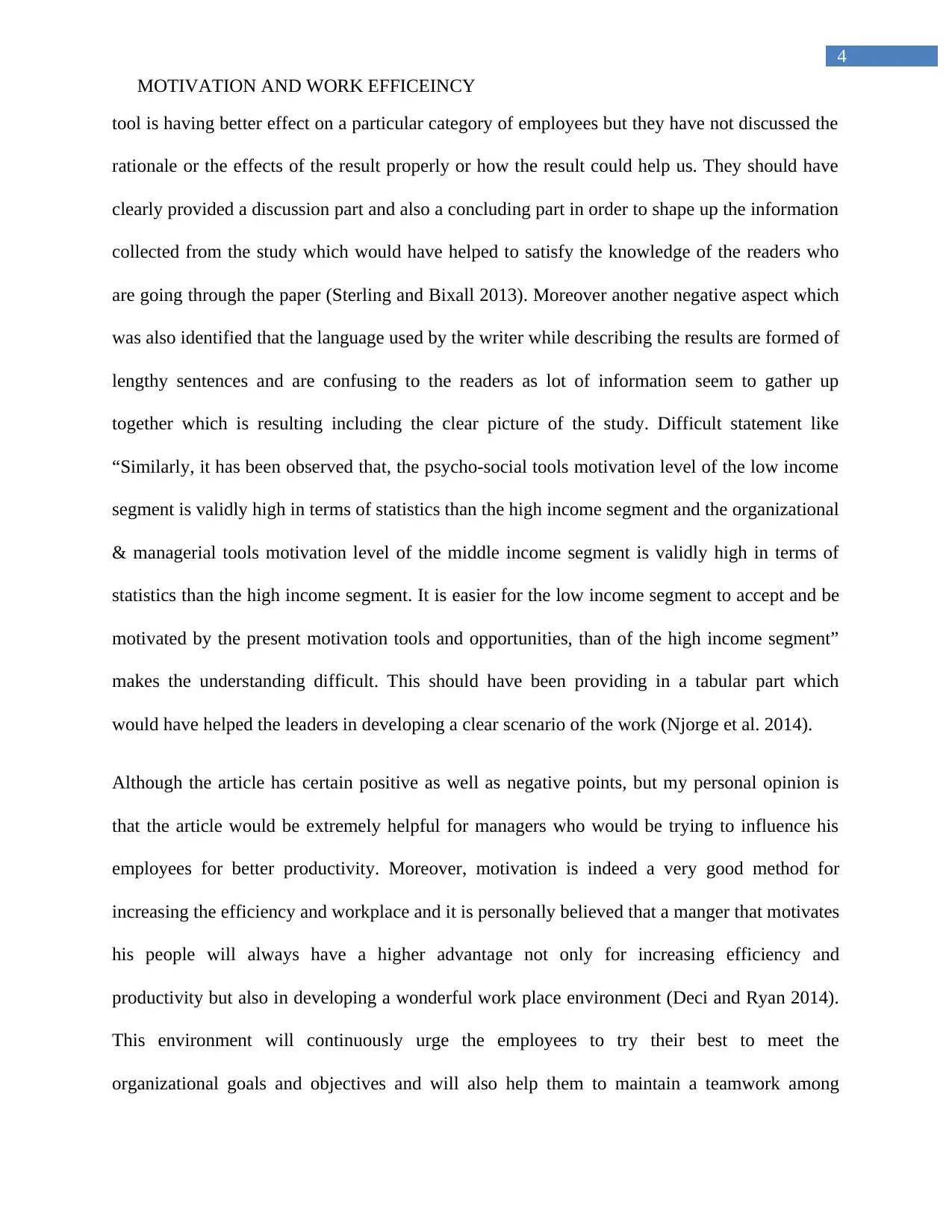
4
MOTIVATION AND WORK EFFICEINCY
tool is having better effect on a particular category of employees but they have not discussed the
rationale or the effects of the result properly or how the result could help us. They should have
clearly provided a discussion part and also a concluding part in order to shape up the information
collected from the study which would have helped to satisfy the knowledge of the readers who
are going through the paper (Sterling and Bixall 2013). Moreover another negative aspect which
was also identified that the language used by the writer while describing the results are formed of
lengthy sentences and are confusing to the readers as lot of information seem to gather up
together which is resulting including the clear picture of the study. Difficult statement like
“Similarly, it has been observed that, the psycho-social tools motivation level of the low income
segment is validly high in terms of statistics than the high income segment and the organizational
& managerial tools motivation level of the middle income segment is validly high in terms of
statistics than the high income segment. It is easier for the low income segment to accept and be
motivated by the present motivation tools and opportunities, than of the high income segment”
makes the understanding difficult. This should have been providing in a tabular part which
would have helped the leaders in developing a clear scenario of the work (Njorge et al. 2014).
Although the article has certain positive as well as negative points, but my personal opinion is
that the article would be extremely helpful for managers who would be trying to influence his
employees for better productivity. Moreover, motivation is indeed a very good method for
increasing the efficiency and workplace and it is personally believed that a manger that motivates
his people will always have a higher advantage not only for increasing efficiency and
productivity but also in developing a wonderful work place environment (Deci and Ryan 2014).
This environment will continuously urge the employees to try their best to meet the
organizational goals and objectives and will also help them to maintain a teamwork among
MOTIVATION AND WORK EFFICEINCY
tool is having better effect on a particular category of employees but they have not discussed the
rationale or the effects of the result properly or how the result could help us. They should have
clearly provided a discussion part and also a concluding part in order to shape up the information
collected from the study which would have helped to satisfy the knowledge of the readers who
are going through the paper (Sterling and Bixall 2013). Moreover another negative aspect which
was also identified that the language used by the writer while describing the results are formed of
lengthy sentences and are confusing to the readers as lot of information seem to gather up
together which is resulting including the clear picture of the study. Difficult statement like
“Similarly, it has been observed that, the psycho-social tools motivation level of the low income
segment is validly high in terms of statistics than the high income segment and the organizational
& managerial tools motivation level of the middle income segment is validly high in terms of
statistics than the high income segment. It is easier for the low income segment to accept and be
motivated by the present motivation tools and opportunities, than of the high income segment”
makes the understanding difficult. This should have been providing in a tabular part which
would have helped the leaders in developing a clear scenario of the work (Njorge et al. 2014).
Although the article has certain positive as well as negative points, but my personal opinion is
that the article would be extremely helpful for managers who would be trying to influence his
employees for better productivity. Moreover, motivation is indeed a very good method for
increasing the efficiency and workplace and it is personally believed that a manger that motivates
his people will always have a higher advantage not only for increasing efficiency and
productivity but also in developing a wonderful work place environment (Deci and Ryan 2014).
This environment will continuously urge the employees to try their best to meet the
organizational goals and objectives and will also help them to maintain a teamwork among
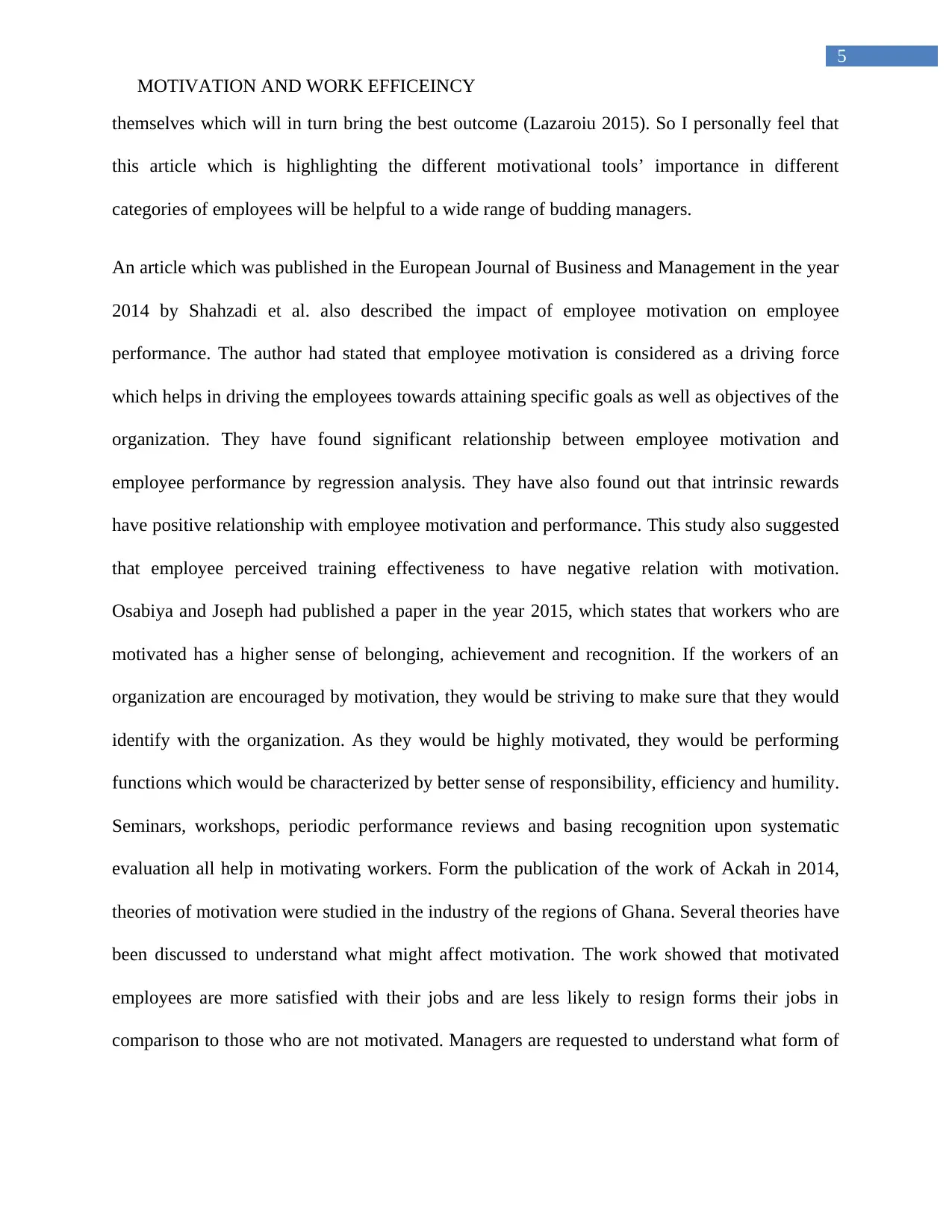
5
MOTIVATION AND WORK EFFICEINCY
themselves which will in turn bring the best outcome (Lazaroiu 2015). So I personally feel that
this article which is highlighting the different motivational tools’ importance in different
categories of employees will be helpful to a wide range of budding managers.
An article which was published in the European Journal of Business and Management in the year
2014 by Shahzadi et al. also described the impact of employee motivation on employee
performance. The author had stated that employee motivation is considered as a driving force
which helps in driving the employees towards attaining specific goals as well as objectives of the
organization. They have found significant relationship between employee motivation and
employee performance by regression analysis. They have also found out that intrinsic rewards
have positive relationship with employee motivation and performance. This study also suggested
that employee perceived training effectiveness to have negative relation with motivation.
Osabiya and Joseph had published a paper in the year 2015, which states that workers who are
motivated has a higher sense of belonging, achievement and recognition. If the workers of an
organization are encouraged by motivation, they would be striving to make sure that they would
identify with the organization. As they would be highly motivated, they would be performing
functions which would be characterized by better sense of responsibility, efficiency and humility.
Seminars, workshops, periodic performance reviews and basing recognition upon systematic
evaluation all help in motivating workers. Form the publication of the work of Ackah in 2014,
theories of motivation were studied in the industry of the regions of Ghana. Several theories have
been discussed to understand what might affect motivation. The work showed that motivated
employees are more satisfied with their jobs and are less likely to resign forms their jobs in
comparison to those who are not motivated. Managers are requested to understand what form of
MOTIVATION AND WORK EFFICEINCY
themselves which will in turn bring the best outcome (Lazaroiu 2015). So I personally feel that
this article which is highlighting the different motivational tools’ importance in different
categories of employees will be helpful to a wide range of budding managers.
An article which was published in the European Journal of Business and Management in the year
2014 by Shahzadi et al. also described the impact of employee motivation on employee
performance. The author had stated that employee motivation is considered as a driving force
which helps in driving the employees towards attaining specific goals as well as objectives of the
organization. They have found significant relationship between employee motivation and
employee performance by regression analysis. They have also found out that intrinsic rewards
have positive relationship with employee motivation and performance. This study also suggested
that employee perceived training effectiveness to have negative relation with motivation.
Osabiya and Joseph had published a paper in the year 2015, which states that workers who are
motivated has a higher sense of belonging, achievement and recognition. If the workers of an
organization are encouraged by motivation, they would be striving to make sure that they would
identify with the organization. As they would be highly motivated, they would be performing
functions which would be characterized by better sense of responsibility, efficiency and humility.
Seminars, workshops, periodic performance reviews and basing recognition upon systematic
evaluation all help in motivating workers. Form the publication of the work of Ackah in 2014,
theories of motivation were studied in the industry of the regions of Ghana. Several theories have
been discussed to understand what might affect motivation. The work showed that motivated
employees are more satisfied with their jobs and are less likely to resign forms their jobs in
comparison to those who are not motivated. Managers are requested to understand what form of
⊘ This is a preview!⊘
Do you want full access?
Subscribe today to unlock all pages.

Trusted by 1+ million students worldwide
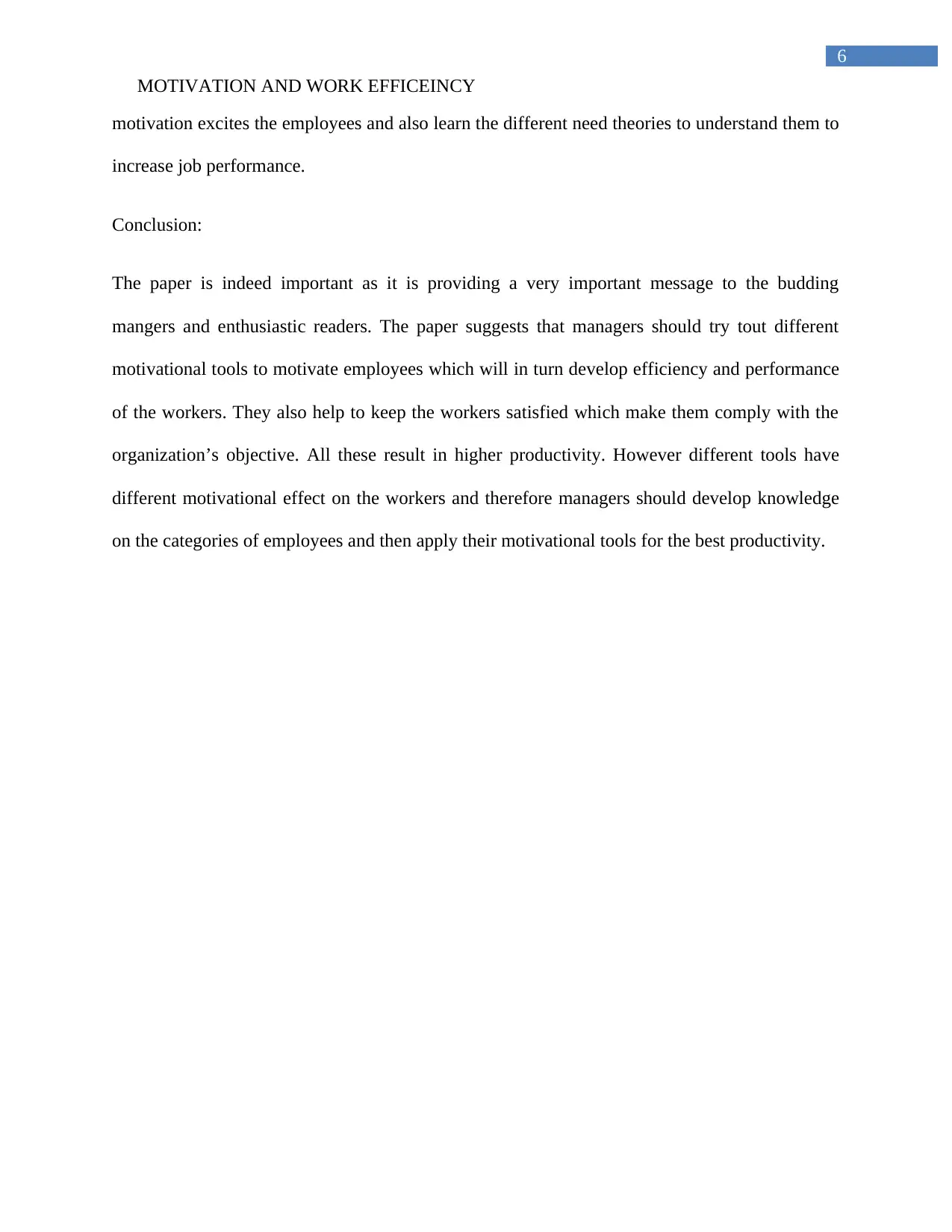
6
MOTIVATION AND WORK EFFICEINCY
motivation excites the employees and also learn the different need theories to understand them to
increase job performance.
Conclusion:
The paper is indeed important as it is providing a very important message to the budding
mangers and enthusiastic readers. The paper suggests that managers should try tout different
motivational tools to motivate employees which will in turn develop efficiency and performance
of the workers. They also help to keep the workers satisfied which make them comply with the
organization’s objective. All these result in higher productivity. However different tools have
different motivational effect on the workers and therefore managers should develop knowledge
on the categories of employees and then apply their motivational tools for the best productivity.
MOTIVATION AND WORK EFFICEINCY
motivation excites the employees and also learn the different need theories to understand them to
increase job performance.
Conclusion:
The paper is indeed important as it is providing a very important message to the budding
mangers and enthusiastic readers. The paper suggests that managers should try tout different
motivational tools to motivate employees which will in turn develop efficiency and performance
of the workers. They also help to keep the workers satisfied which make them comply with the
organization’s objective. All these result in higher productivity. However different tools have
different motivational effect on the workers and therefore managers should develop knowledge
on the categories of employees and then apply their motivational tools for the best productivity.
Paraphrase This Document
Need a fresh take? Get an instant paraphrase of this document with our AI Paraphraser
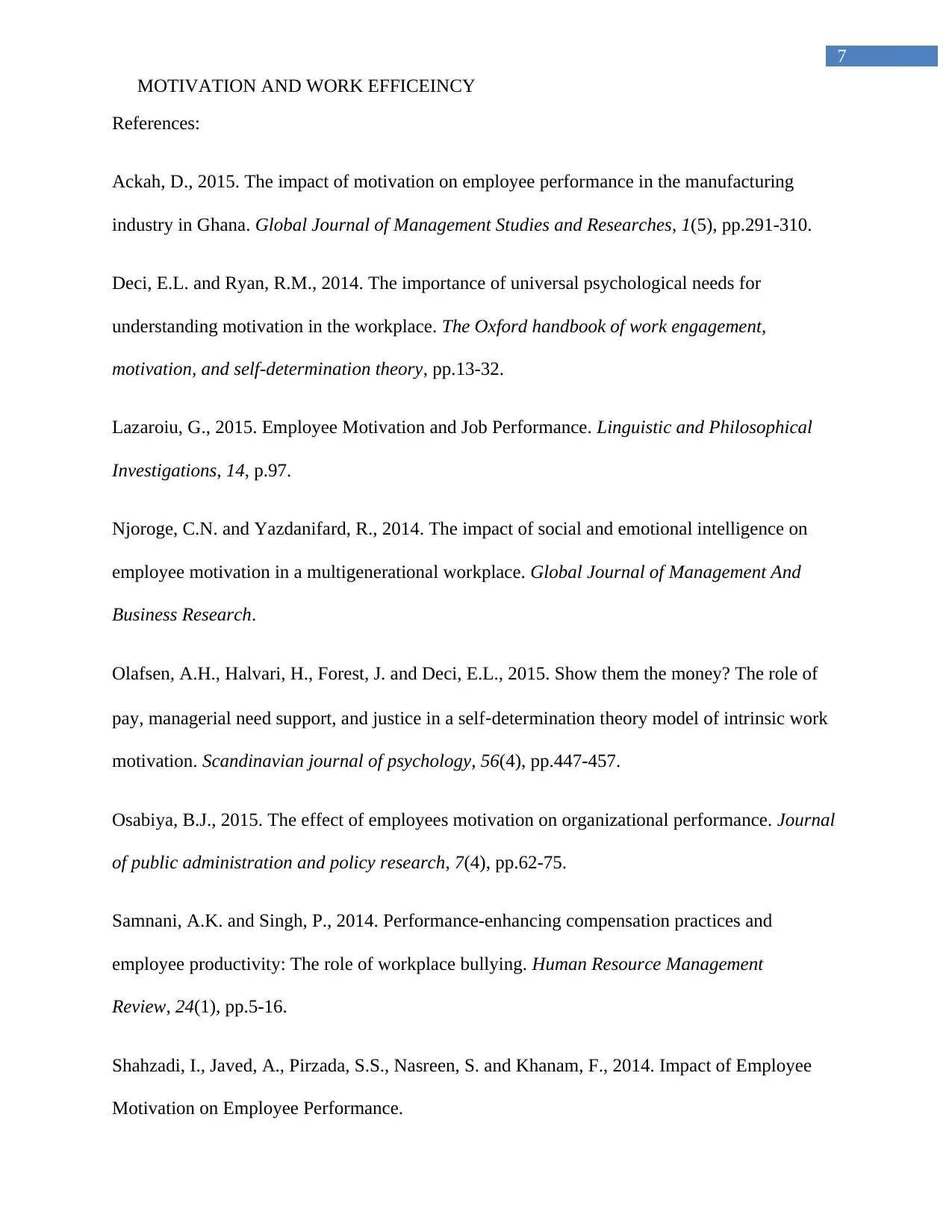
7
MOTIVATION AND WORK EFFICEINCY
References:
Ackah, D., 2015. The impact of motivation on employee performance in the manufacturing
industry in Ghana. Global Journal of Management Studies and Researches, 1(5), pp.291-310.
Deci, E.L. and Ryan, R.M., 2014. The importance of universal psychological needs for
understanding motivation in the workplace. The Oxford handbook of work engagement,
motivation, and self-determination theory, pp.13-32.
Lazaroiu, G., 2015. Employee Motivation and Job Performance. Linguistic and Philosophical
Investigations, 14, p.97.
Njoroge, C.N. and Yazdanifard, R., 2014. The impact of social and emotional intelligence on
employee motivation in a multigenerational workplace. Global Journal of Management And
Business Research.
Olafsen, A.H., Halvari, H., Forest, J. and Deci, E.L., 2015. Show them the money? The role of
pay, managerial need support, and justice in a self‐determination theory model of intrinsic work
motivation. Scandinavian journal of psychology, 56(4), pp.447-457.
Osabiya, B.J., 2015. The effect of employees motivation on organizational performance. Journal
of public administration and policy research, 7(4), pp.62-75.
Samnani, A.K. and Singh, P., 2014. Performance-enhancing compensation practices and
employee productivity: The role of workplace bullying. Human Resource Management
Review, 24(1), pp.5-16.
Shahzadi, I., Javed, A., Pirzada, S.S., Nasreen, S. and Khanam, F., 2014. Impact of Employee
Motivation on Employee Performance.
MOTIVATION AND WORK EFFICEINCY
References:
Ackah, D., 2015. The impact of motivation on employee performance in the manufacturing
industry in Ghana. Global Journal of Management Studies and Researches, 1(5), pp.291-310.
Deci, E.L. and Ryan, R.M., 2014. The importance of universal psychological needs for
understanding motivation in the workplace. The Oxford handbook of work engagement,
motivation, and self-determination theory, pp.13-32.
Lazaroiu, G., 2015. Employee Motivation and Job Performance. Linguistic and Philosophical
Investigations, 14, p.97.
Njoroge, C.N. and Yazdanifard, R., 2014. The impact of social and emotional intelligence on
employee motivation in a multigenerational workplace. Global Journal of Management And
Business Research.
Olafsen, A.H., Halvari, H., Forest, J. and Deci, E.L., 2015. Show them the money? The role of
pay, managerial need support, and justice in a self‐determination theory model of intrinsic work
motivation. Scandinavian journal of psychology, 56(4), pp.447-457.
Osabiya, B.J., 2015. The effect of employees motivation on organizational performance. Journal
of public administration and policy research, 7(4), pp.62-75.
Samnani, A.K. and Singh, P., 2014. Performance-enhancing compensation practices and
employee productivity: The role of workplace bullying. Human Resource Management
Review, 24(1), pp.5-16.
Shahzadi, I., Javed, A., Pirzada, S.S., Nasreen, S. and Khanam, F., 2014. Impact of Employee
Motivation on Employee Performance.
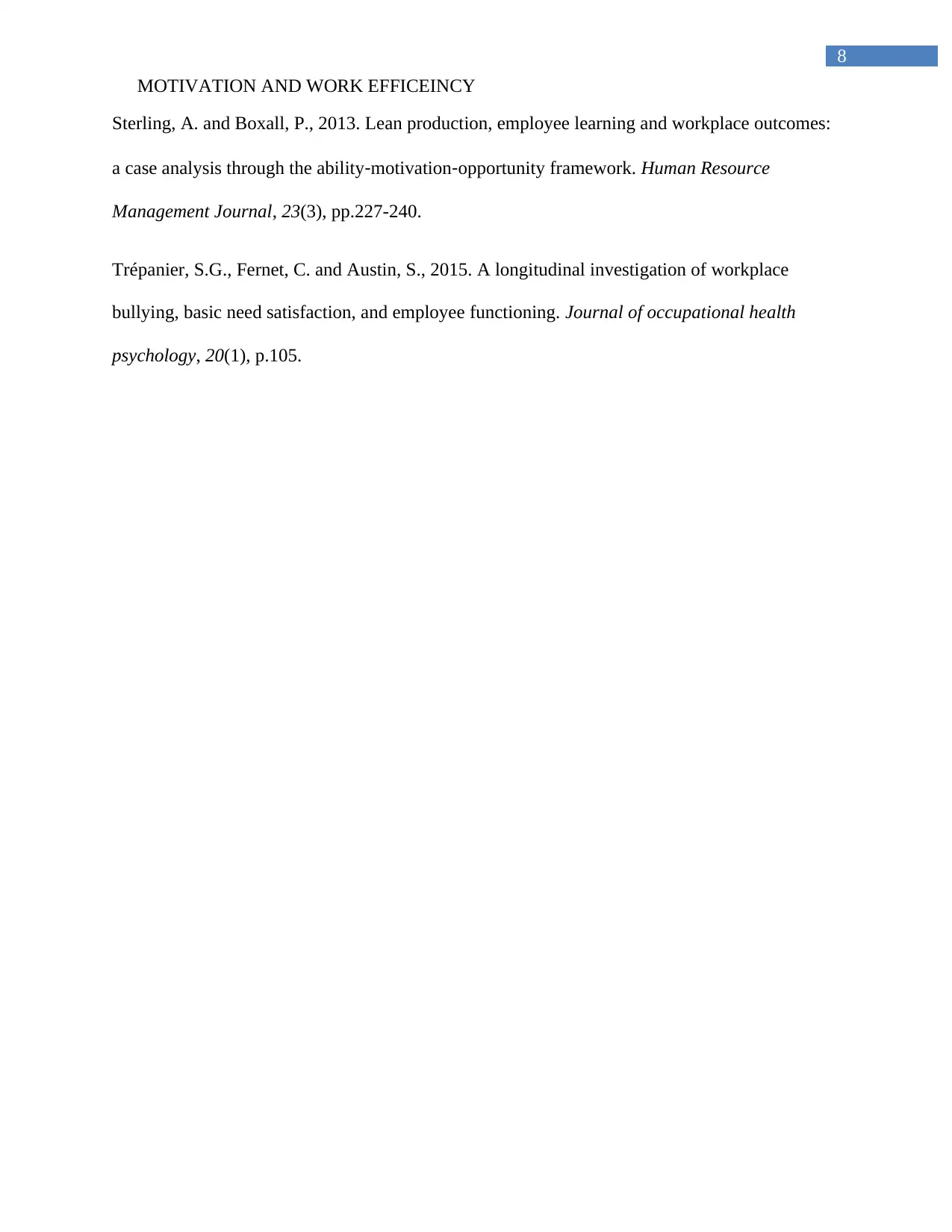
8
MOTIVATION AND WORK EFFICEINCY
Sterling, A. and Boxall, P., 2013. Lean production, employee learning and workplace outcomes:
a case analysis through the ability‐motivation‐opportunity framework. Human Resource
Management Journal, 23(3), pp.227-240.
Trépanier, S.G., Fernet, C. and Austin, S., 2015. A longitudinal investigation of workplace
bullying, basic need satisfaction, and employee functioning. Journal of occupational health
psychology, 20(1), p.105.
MOTIVATION AND WORK EFFICEINCY
Sterling, A. and Boxall, P., 2013. Lean production, employee learning and workplace outcomes:
a case analysis through the ability‐motivation‐opportunity framework. Human Resource
Management Journal, 23(3), pp.227-240.
Trépanier, S.G., Fernet, C. and Austin, S., 2015. A longitudinal investigation of workplace
bullying, basic need satisfaction, and employee functioning. Journal of occupational health
psychology, 20(1), p.105.
⊘ This is a preview!⊘
Do you want full access?
Subscribe today to unlock all pages.

Trusted by 1+ million students worldwide
1 out of 9
Related Documents
Your All-in-One AI-Powered Toolkit for Academic Success.
+13062052269
info@desklib.com
Available 24*7 on WhatsApp / Email
![[object Object]](/_next/static/media/star-bottom.7253800d.svg)
Unlock your academic potential
Copyright © 2020–2025 A2Z Services. All Rights Reserved. Developed and managed by ZUCOL.





